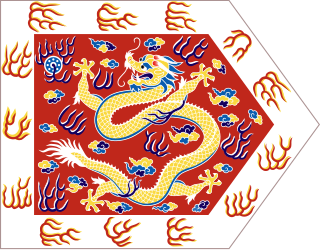 W
WThe Bordered Red Banner was one of the Eight Banners of the Manchu military and society among the lower five banners during the Later Jin and Qing dynasty of China.
 W
WThe Bordered White Banner was one of the Eight Banners of Manchu military and society during the Later Jin and Qing dynasty of China. It was among the lower five banners.
 W
WThe Bordered Yellow Banner was one of the Eight Banners of Manchu military and society during the Later Jin and Qing dynasty of China. The Bordered Yellow Banner was one of three "upper" banner armies under the direct command of the emperor himself, and one of the four "left wing" banners. The Plain Yellow Banner and the Bordered Yellow Banner were split from each other in 1615, when the troops of the original four banner armies were divided into eight by adding a bordered variant to each banner's design. The yellow banners were originally commanded personally by Nurhaci. After Nurhaci's death, his son Hong Taiji became khan, and took control of both yellow banners. Later, the Shunzhi Emperor took over the Plain White Banner after the death of his regent, Dorgon, to whom it previously belonged. From that point forward, the emperor directly controlled three "upper" banners, as opposed to the other five "lower" banners. Because of the direct control of the three upper banners, there was no appointed banner commanders as opposed to the other five. The emperor's personal guards and guards of Forbidden City were also only selected from the upper three banners.
 W
WThe Plain Red Banner was one of the Eight Banners of Manchu military and society during the Later Jin and Qing dynasty of China. Members included:Daišan Wenxiang Heshen, Clan Niohuru, considered one of the most corrupt officials in history Zheng Keshuang (Han)
 W
WThe Plain White Banner was one of the Eight Banners of Manchu military and society during the Later Jin and Qing dynasty of China. It was one of the three "upper" banners directly controlled by the emperor, as opposed to the other five "lower" banners. The Hoise Niru was a military unit associated with the Plain White Banner. Members included:
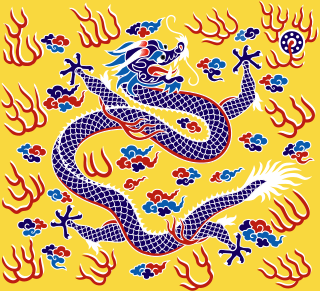 W
WThe Plain Yellow Banner was one of the Eight Banners of Manchu military and society during the Later Jin and Qing dynasty of China. The Plain Yellow Banner was one of three "upper" banner armies under the direct command of the emperor himself, and one of the four "right wing" banners. The Plain Yellow Banner was the original banner commanded personally by Nurhaci. The Plain Yellow Banner and the Bordered Yellow Banner were split from each other in 1615, when the troops of the original four banner armies were divided into eight by adding a bordered variant to each banner's design. After Nurhaci's death, his son Hong Taiji became khan, and took control of both yellow banners. Later, the Shunzhi Emperor took over the Plain White Banner after the death of his regent, Dorgon, to whom it previously belonged. From that point forward, the emperor directly controlled three "upper" banners, as opposed to the other five "lower" banners.
 W
WThe 1911 Revolution, or Xinhai Revolution, ended China's last imperial dynasty and lead to the establishment of the Republic of China. The revolution culminated a decade of agitation, revolts, and uprisings. Its success marked the end of 2,132 years of imperial rule, 276 years of the Qing dynasty, and the beginning of China's early republican era.
 W
WAnti-Qing sentiment refers to a sentiment principally held in China against the rule of the Manchu-led Qing dynasty (1636–1912), which was criticized by opponents as being "barbaric". The Qing was accused of destroying traditional Han culture by forcing Han to wear their hair in a queue in the Manchu style. It was blamed for suppressing Chinese science, causing China to be transformed from the world's premiere power to a poor, backwards nation. The people of the Eight Banners lived off government pensions unlike the general Han civilian population.
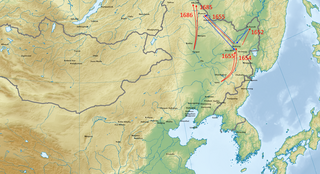 W
WThe Battle of Hutong was a military conflict between the Tsardom of Russia and the Qing dynasty which occurred in the spring of 1654 on the Songhua River. Korean musketeers were also present from Joseon. It resulted in the retreat of Russian forces.
 W
WThe Battle of Hutong was a military conflict which occurred on 10 June 1658 between the Tsardom of Russia and the Qing dynasty and Joseon. It resulted in Russian defeat.
 W
WThe Battle of Jao Modo also known as the Battle of Zuunmod, was fought on June 12, 1696 on the banks of the upper Terelj river 60 kilometres (37 mi) east of the modern-day Mongolian capital Ulaanbaatar. A Dzungar-Mongol army under the command of Galdan Boshugtu Khan was defeated by Qing armies personally led by the Kangxi Emperor. This decisive Qing victory in the early stages of the Dzungar–Qing Wars (1687–1758) effectively incorporated Khalkha Mongolia under Qing rule and relegated Dzungar Mongol forces to Inner Asia until they were finally defeated in 1758.
 W
WThe Bordered Blue Banner was one of the Eight Banners of Manchu military and society during the Later Jin and Qing dynasty of China. It was one of the lower five banners. According to the general annals of the Eight Banners, the Bordered Blue Banner was one of the banners located on the south right wing.
 W
WThe Boxer Rebellion, Boxer Uprising or Yihetuan Movement, was an armed insurrection in China between 1899 and 1901, towards the end of the Qing dynasty. It was initiated against the increasing foreign intervention including Christian missionary work in the country, by the Militia United in Righteousness (Yìhéquán), known in English as the Boxers because many of their members had practised Chinese martial arts, also referred to in the Western world at the time as Chinese Boxing.
 W
WThe First Opium War, also known as the Opium War or the Anglo-Chinese War, was a series of military engagements fought between Britain and the Qing dynasty of China. The immediate issue was China's official seizure of opium stocks at Canton to stop the banned opium trade, and threatening the death penalty for future offenders. The British government insisted on the principles of free trade, equal diplomatic recognition among nations, and backed the merchants' demands. The British navy defeated the Chinese using technologically superior ships and weapons, and the British then imposed a treaty that granted territory to Britain and opened trade with China.
 W
WThe flag of the Qing dynasty was an emblem adopted in the late 19th century featuring the Azure Dragon on a plain yellow field with the red flaming pearl in the upper left corner. It became the first national flag of China and is usually referred to as the "Yellow Dragon Flag".
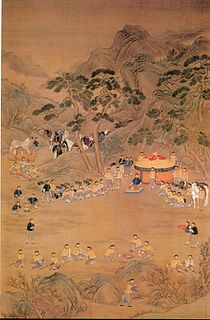 W
WThe imperial hunt of the Qing dynasty was an annual rite of the emperors of China during the Qing dynasty (1636–1912). It was first organized in 1681 by the Kangxi Emperor at the imperial hunting grounds at Mulan (modern-day Weichang Manchu and Mongol Autonomous County, near what would become the summer residence of the Qing emperors at Chengde. Starting in 1683 the event was held annually at Mulan during the autumn, lasting up to a month. The Qing dynasty hunt was a synthesis of earlier Chinese and Inner Asian hunting traditions, particularly those of the Manchus and Mongols. The emperor himself participated in the hunt, along with thousands of soldiers, imperial family members, and government officials.
 W
WManchuria under Qing rule was the rule of the Qing dynasty over Manchuria, including today's Northeast China and Outer Manchuria. The Qing dynasty itself was established by the Manchus, a Tungusic people coming from Manchuria, who later replaced the Ming dynasty as the legitimate dynasty of China. Thus, Manchuria enjoyed a somewhat special status during the Qing and was not governed as regular provinces until the late Qing dynasty.
 W
WThe Qing dynasty (1636–1912) was established by conquest and maintained by armed force. The founding emperors personally organized and led the armies, and the continued cultural and political legitimacy of the dynasty depended on the ability to defend the country from invasion and expand its territory. Therefore, military institutions, leadership, and finance were fundamental to the dynasty's initial success and ultimate decay. The early military system centered on the Eight Banners, a hybrid institution that also played social, economic, and political roles. The Banner system was developed on an informal basis as early as 1601, and formally established in 1615 by Jurchen leader Nurhaci (1559–1626), the retrospectively recognized founder of the Qing. His son Hong Taiji (1592–1643), who renamed the Jurchens "Manchus," created eight Mongol banners to mirror the Manchu ones and eight "Han-martial" banners manned by Chinese who surrendered to the Qing before the full-fledged conquest of China proper began in 1644. After 1644, the Ming Chinese troops that surrendered to the Qing were integrated into the Green Standard Army, a corps that eventually outnumbered the Banners by three to one.
 W
WThe Second Opium War, also known as the Second Anglo-Chinese War, the Second China War, the Arrow War, or the Anglo-French expedition to China, was a war pitting the British Empire and the French Empire against the Qing dynasty of China that lasted from 1856 to 1860.
 W
WOros Niru was a Manchu military unit of Qing dynasty China. It consisted of Russian Cossacks that were captured during the border conflicts between the Russian empire and Qing China. Formally, this niru was known as the 17th niru of the 4th jalan of the Manju Gusa ejen of Bordered Yellow Banner(鑲黃旗滿洲都統第四參領第十七佐領).
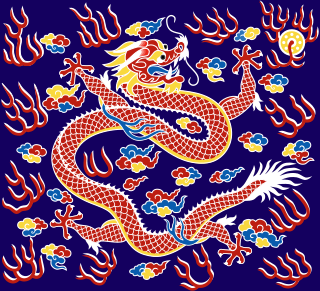 W
WThe Plain Blue Banner was one of the Eight Banners of Manchu military and society during the Later Jin and Qing dynasty of China.
 W
WThe Qing invasion of Joseon occurred in the winter of 1636 when the newly established Manchu-led Qing dynasty invaded the Joseon dynasty, establishing its status as the center of the Imperial Chinese Tributary System and formally severing Joseon's relationship with the Ming dynasty. The invasion was preceded by the Later Jin invasion of Joseon in 1627.
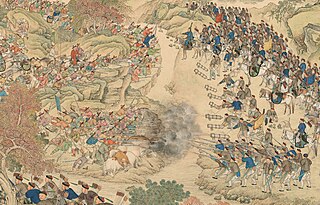 W
WThe Revolt of the Altishahr Khojas was an uprising against the Qing dynasty of China, which broke out in 1757 during the reign of the Qianlong Emperor. The rebels were led by Khwāja-i Jahān, leader of the White Mountain Sufis. Qing era documents refer to the event as the "Pacification of the Muslim regions". Hojijan and his brother, Burhān al-Dīn, both held the Muslim title Khoja.
 W
WThe Revolt of the Three Feudatories, also known as the Rebellion of Wu Sangui, was a rebellion in China lasting from 1673 to 1681, during the early reign of the Kangxi Emperor of the Qing dynasty (1644–1912). The revolt was led by the three lords of the fiefdoms in Yunnan, Guangdong and Fujian provinces against the Qing central government. These hereditary titles had been given to prominent Han Chinese defectors who had helped the Manchu conquer China during the transition from Ming to Qing. The feudatories were supported by Zheng Jing's Kingdom of Tungning in Taiwan, which sent forces to invade Mainland China. Additionally, minor Han military figures, such as Wang Fuchen and the Chahar Mongols, also revolted against Qing rule. After the last remaining Han resistance had been put down, the former princely titles were abolished.
 W
WThe Sino-Burmese War, also known as the Qing invasions of Burma or the Myanmar campaign of the Qing dynasty, was a war fought between the Qing dynasty of China and the Konbaung dynasty of Burma (Myanmar). China under the Qianlong Emperor launched four invasions of Burma between 1765 and 1769, which were considered one of his Ten Great Campaigns. Nonetheless, the war, which claimed the lives of over 70,000 Chinese soldiers and four commanders, is sometimes described as "the most disastrous frontier war that the Qing dynasty had ever waged", and one that "assured Burmese independence". Burma's successful defense laid the foundation for the present-day boundary between the two countries.
 W
WThe Sino-Russian border conflicts (1652–1689) were a series of intermittent skirmishes between the Qing dynasty, with assistance from the Joseon dynasty of Korea, and the Tsardom of Russia by the Cossacks in which the latter tried and failed to gain the land north of the Amur River with disputes over the Amur region. The hostilities culminated in the Qing siege of the Cossack fort of Albazin (1686) and resulted in the Treaty of Nerchinsk in 1689 which gave the land to China.
 W
WThe Taiping Rebellion, also known as the Taiping Civil War or the Taiping Revolution, was a massive rebellion or civil war that was waged in China between the Manchu Qing dynasty and the Han, Hakka-led Taiping Heavenly Kingdom. It lasted from 1850 to 1864, although following the fall of Nanjing the last rebel army was not wiped out until 1871. After fighting the bloodiest civil war in world history, with 30 to 50 million dead, the established Qing government won decisively, although the outcome is considered a pyrrhic victory.
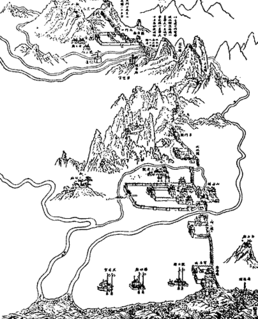 W
WThe transition from Ming to Qing, Ming–Qing transition, or Manchu conquest of China from 1618 to 1683 saw the transition between two major dynasties in Chinese history. It was the decades-long conflict between the emergent Qing dynasty (清朝), the incumbent Ming dynasty (明朝), and several smaller factions in China. It ended with the rise of the Qing, and the fall of the Ming and other factions.
 W
WThe Qing dynasty ruled over Xinjiang from the late 1750s to 1912. In the history of Xinjiang, the Qing rule was established in the final phase of the Dzungar–Qing Wars when the Dzungar Khanate was conquered by the Manchu-led Qing dynasty of China, and lasted until the fall of the Qing dynasty in 1912. The post of General of Ili was established to govern the whole of Xinjiang and reported to the Lifan Yuan, a Qing government agency that oversaw the empire's frontier regions. Xinjiang was turned into a province in 1884.